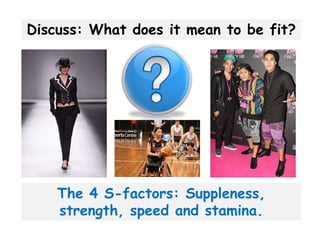8B Lesson 1 fitness
- 1. Discuss: What does it mean to be fit? The 4 S-factors: Suppleness, strength, speed and stamina.
- 2. What does it mean to be fit? If you are fit, your body is well set up for exercise. For exercise your muscle cells need energy. Where does this come from? oxygen carbon dioxide respiration water glucose energy Which organ systems provide the things you need for respiration?
- 3. Explore How much does pulse rate change with different types of activities?
- 4. Summary ŌĆō Pulse rate activity 1. Why does your pulse change when you do some activities? 2. Which activity gave the highest pulse rate? 3. What sort of activity would give you a higher pulse rate? 4. What might you be doing if you had a lower pulse rate? 5. When your heart is beating faster, what is happening in your body? 6. Why do different people have different pulse rates?
- 5. What process is this animation showing? Where is it happening? How is this linked to fitness and stamina?
- 6. Explain Sequence correctly what happens inside our bodies when we run up and down the stairs.
- 7. When I started to run up and down the This was detected by my brain which stairsŌĆ” sent nerve impulses to the heart. 1 6 Glucose reacted with oxygen, releasing The heart started to beat faster and energy. At the same time, carbon harder to move my blood faster. dioxide and water were produced. The energy needed for this came from a chemical reaction in the muscle cells My heart rate went back to normal. called respiration. 3 10 Very soon, my muscle cells started to My heart and blood system was able to run short of oxygen and acidic carbon supply enough oxygen to the muscle dioxide started to build up in the blood. cells. When I stopped running up and down My leg muscles contracted to lift my the stairs, the respiration in my muscle body. cells slowed down.
- 8. When I started to run up and down the This was detected by my brain which stairsŌĆ” sent nerve impulses to the heart. 1 6 Glucose reacted with oxygen, releasing The heart started to beat faster and energy. At the same time, carbon harder to move my blood faster. dioxide and water were produced. 7 4 The energy needed for this came from a chemical reaction in the muscle cells My heart rate went back to normal. called respiration. 3 10 Very soon, my muscle cells started to My heart and blood system was able to run short of oxygen and acidic carbon supply enough oxygen to the muscle dioxide started to build up in the blood. cells. 5 9 When I stopped running up and down My leg muscles contracted to lift my the stairs, the respiration in my muscle body. cells slowed down. 8 2
- 9. Check list 1. Can you explain what fitness means? 2. What are the 4 S-factors 3. Name the chemical reaction that releases energy to keep your muscles moving. 4. Explain why it is important that our organ systems work efficiently. 5. Suggest ways of evaluating whether a fitness programme is working.









